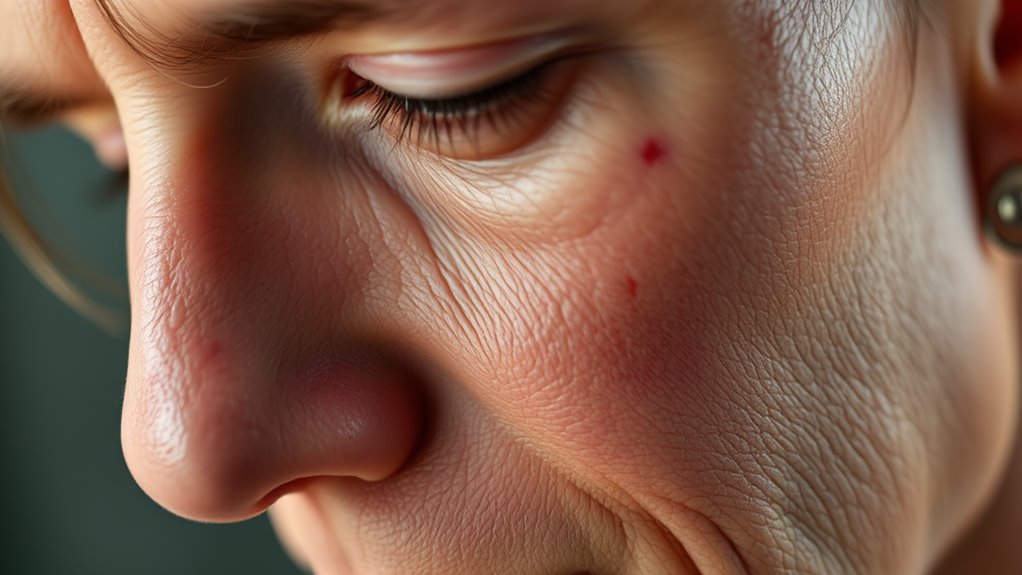What Your Skin Says About Your Stress Levels (And What to Do)
Your skin often signals rising stress through breakouts, redness, or dryness, triggered by elevated cortisol that weakens your protective barrier and sparks inflammation. You’ll notice acne flaring up or eczema worsening during tense periods, as cortisol disrupts oil balance and accelerates aging. Take charge now by practicing mindfulness, deep breathing, and regular exercise to lower cortisol and soothe irritation. Dive into more strategies to build your skin’s resilience and maintain lasting health.
Key Takeaways
- Stress can cause acne, eczema, or hives as visible signs of elevated cortisol levels.
- Elevated cortisol weakens the skin’s barrier, leading to inflammation and breakouts.
- Redness, roughness, or sudden texture changes may indicate hidden stress in your skin.
- Practice mindfulness, exercise, and deep breathing to reduce cortisol and soothe skin issues.
- Adopt a consistent skincare routine with hydrating products and consult a dermatologist for persistent problems.
Common Skin Symptoms Linked to Stress
When you’re under stress, your skin often reacts with symptoms like acne, eczema, or hives, as elevated cortisol levels disrupt its natural barrier and immune functions.
Stress triggers inflammation, making your skin more prone to breakouts and irritation, which you might notice as redness or dryness.
For instance, persistent stress can exacerbate conditions like psoriasis, where flaky patches appear on your body.
You may also experience accelerated aging signs, such as fine lines, due to stress-induced oxidative damage.
Recognizing these skin signals helps you identify stress early; pay attention to sudden rashes or oiliness as key indicators. Drawing from personal experiences shared in explorations of this connection, incorporating targeted approaches can further support skin recovery.
By monitoring your skin’s responses, you’re better equipped to address underlying stress before it worsens.
Remember, skin serves as a visible barometer of your overall well-being, reflecting how stress manifests physically.
Stay vigilant for these common signs to maintain healthier skin resilience.
To effectively manage these stress-related skin issues, consider exploring five practical strategies that promote overall well-being and skin resilience.
How Stress Impacts Skin Health
Stress profoundly affects your skin’s health by elevating cortisol levels, which weaken its protective barrier and trigger inflammation.
This hormone disrupts your skin’s natural oil production, making it more susceptible to environmental damage and microbial invasion.
You’ll find that chronic stress accelerates cellular aging, as cortisol interferes with collagen synthesis and DNA repair processes.
It also impairs your skin’s immune response, allowing minor issues to escalate into larger problems.
By understanding these mechanisms, you’re better equipped to prioritize stress management. For instance, incorporating stress management tips into your daily routine can help reduce cortisol levels and promote healthier skin.
Remember, sustained high cortisol levels can hinder wound healing and exacerbate underlying conditions, underscoring the need for proactive lifestyle adjustments.
Stay vigilant about these internal changes to maintain your skin’s resilience and overall vitality.
Recognizing skin symptoms early can empower you to adopt strategies that mitigate stress and enhance skin health.
Recognizing Stress in Your Skin’s Appearance
You notice stress breakouts appearing on your skin as inflamed pimples or spots, signaling underlying tension.
Redness flares up as a key warning sign, indicating your body’s inflammatory response to stress.
Incorporating soothing strategies can help calm the redness and restore balance to your skin.
Texture changes, like increased roughness or dryness, highlight how stress alters your skin’s natural barrier.
To improve your skin’s resilience, consider avoiding skincare mistakes that can worsen these stress-induced symptoms.
Stress Breakouts Explained
As internal pressures mount, your skin frequently signals stress through unexpected breakouts, such as acne or redness. These occur when heightened cortisol levels trigger excess oil production and inflammation.
This process disrupts your skin’s barrier, allowing bacteria to thrive and pores to clog, often manifesting as painful pimples or persistent blemishes. You can identify stress-related breakouts by their sudden onset during high-tension periods, like work deadlines or personal challenges, typically appearing on the face, back, or chest.
To address this scientifically, monitor your cortisol patterns through journaling or apps, and adopt practical habits like maintaining a consistent skincare routine with non-comedogenic products.
Redness Warning Signs
Redness often flares up as your skin’s immediate response to stress, signaling underlying inflammation that widens blood vessels and heightens sensitivity. You might notice this as flushed cheeks, a burning sensation, or persistent patches on your face and neck, triggered by stress hormones like cortisol that amplify your skin’s reactivity.
Pay attention if redness appears suddenly after high-pressure situations, as it could indicate chronic inflammation affecting your barrier function. To address it, incorporate stress-reduction techniques like deep breathing or mindfulness, which help calm your nervous system and reduce flare-ups.
Use gentle, non-irritating skincare products with soothing ingredients such as aloe vera or chamomile to minimize aggravation. If redness persists despite these efforts, consult a dermatologist for targeted treatments, ensuring you maintain skin health proactively.
Texture Changes Noted
Stress often disrupts your skin’s texture, creating rough patches, enlarged pores, or bumpy surfaces as a direct response to elevated cortisol levels.
This hormone alters oil production, causing inflammation that makes your skin feel uneven or gritty, signaling chronic stress. You might notice these changes through daily checks, as cortisol weakens the skin barrier, allowing irritants to exacerbate roughness.
To manage it, incorporate a simple routine: use a gentle, non-comedogenic exfoliator twice weekly to unclog pores and apply hydrating serums with niacinamide to restore smoothness.
Actively reduce stress by practicing deep breathing or yoga, which lowers cortisol and promotes healing.
Monitor progress by journaling symptoms; if texture issues persist, seek professional advice for targeted treatments.
Consistent action keeps your skin resilient and balanced.
The Biological Connection Between Stress and Skin
When you’re under stress, your body releases hormones that directly affect your skin by triggering barrier breakdown.
These hormones also activate inflammation pathways, heightening your skin’s sensitivity and potential for issues.
Understanding this connection empowers you to manage stress and protect your skin’s health.
Stress Hormones Released
As your body responds to stressors, it actively releases hormones like cortisol and adrenaline, directly influencing skin health by triggering inflammation, accelerating aging, and exacerbating conditions such as acne.
These hormones create a cascade of effects that you can manage through targeted strategies, impacting your skin’s vitality in real time.
-
Cortisol spikes oil production: It overstimulates sebaceous glands, fostering acne and clogged pores, which you can counter with balanced routines.
-
Adrenaline boosts blood flow: This heightens skin sensitivity and redness, making you more prone to flare-ups during high-stress periods.
-
Hormones accelerate cellular damage*: They promote *oxidative stress, speeding up wrinkle formation and loss of elasticity over time.
-
Exacerbation of skin issues: Cortisol and adrenaline intensify conditions like acne, leading to persistent breakouts that demand proactive intervention.
Skin Barrier Breakdown
Cortisol and adrenaline compromise your skin’s protective barrier by disrupting its lipid layers and proteins. This breakdown increases transepidermal water loss, leaving your skin dry, sensitive, and prone to external irritants. As stress surges, you lose the barrier’s ability to retain moisture and defend against pollutants, accelerating aging and damage. Understanding this connection empowers you to act proactively.
| Aspect | Stress Impact | Practical Step |
|---|---|---|
| Lipid Layers | Reduces oil balance | Use gentle, hydrating cleansers |
| Proteins | Weakens structural integrity | Apply barrier-repair creams |
| Overall Barrier | Heightens vulnerability | Maintain a consistent routine |
Inflammation Pathways Activated
Stress directly triggers inflammation pathways in your skin, unleashing a cascade of immune responses that amplify redness and irritation.
This happens as stress hormones like cortisol activate your immune system, promoting chronic inflammation that disrupts skin health. You’ll notice this through heightened sensitivity and breakouts, as your body’s defense mechanisms overreact.
To understand the key pathways, consider these:
- Your adrenal glands release cortisol, which signals immune cells to produce inflammatory molecules.
- Pro-inflammatory cytokines surge, directly irritating skin tissues and causing swelling.
- Mast cells in your dermis degranulate, releasing histamine that intensifies redness and itching.
- Blood vessel permeability increases, allowing more immune cells to flood the area, prolonging inflammation.
Practical Tips for Managing Stress-Related Skin Issues
While everyday stressors may aggravate your skin, you’ll find that simple, evidence-based strategies can help restore balance.
Start with mindfulness meditation, which research shows lowers cortisol and reduces inflammation in as little as 10 minutes daily. You actively engage in deep breathing exercises, like the 4-7-8 technique, to quickly calm your nervous system and ease redness or breakouts.
Incorporate progressive muscle relaxation to release tension, targeting areas where stress manifests physically. For persistent issues, consult a dermatologist who can prescribe targeted treatments, such as topical anti-inflammatories, backed by clinical studies.
Track your symptoms in a journal to identify triggers, empowering you to intervene early. Remember, consistent application of these techniques yields measurable improvements in skin health.
To further care for sensitive skin, avoid five critical actions that can irritate it and disrupt soothing routines.
Additionally, to prevent further irritation from your skincare routine, be aware of ingredient sensitivities that can exacerbate redness when combined with stress.
Lifestyle Changes to Alleviate Stress and Soothe Skin
Adopting simple yet impactful lifestyle changes empowers you to reduce stress and enhance your skin’s resilience.
Scientifically, these adjustments lower cortisol levels, which can inflame and age your skin, while promoting overall well-being.
Focus on practical, evidence-based habits to create lasting improvements. Furthermore, by emphasizing essential nutrients in your diet, you can support healthier skin and hair alongside these changes.
-
Incorporate regular exercise****: You’ll boost endorphins and circulation, helping to diminish stress-induced breakouts and dullness.
-
Adopt a nutrient-rich diet****: Eating foods high in vitamins C and E fortifies your skin’s barrier, reducing inflammation from oxidative stress.
-
Prioritize quality sleep****: Aiming for 7-9 hours nightly allows your body to repair skin damage caused by stress hormones.
-
Engage in relaxation practices****: Techniques like deep breathing activate your parasympathetic nervous system, easing tension and soothing irritated skin.
To further support your skin and hair, consider incorporating nutritional guidelines that promote a balanced diet for optimal health and beauty.
Strategies for Maintaining Healthy Skin Amid Stress
Maintaining healthy skin during stressful periods involves targeted strategies that build on your lifestyle changes, such as monitoring and managing environmental factors.
You prioritize a consistent routine: gently cleanse twice daily, apply broad-spectrum SPF, and incorporate serums with antioxidants like vitamin C to combat oxidative stress. Additionally, avoiding over-exfoliation helps protect the skin barrier from potential damage.
Actively manage cortisol by practicing mindfulness meditation or aerobic exercise, which reduces inflammation and prevents breakouts.
Hydrate internally with at least eight glasses of water daily and nutrient-dense foods—think leafy greens for zinc and omega-3s from fish—to support skin barrier function.
Track environmental triggers, like pollution or humidity, using a journal, and consult a dermatologist promptly for personalized adjustments.
You’ll notice clearer skin as these habits integrate seamlessly into your routine.
Furthermore, by avoiding common mistakes in your skincare practices, you can enhance the effectiveness of these strategies for long-term skin health.

